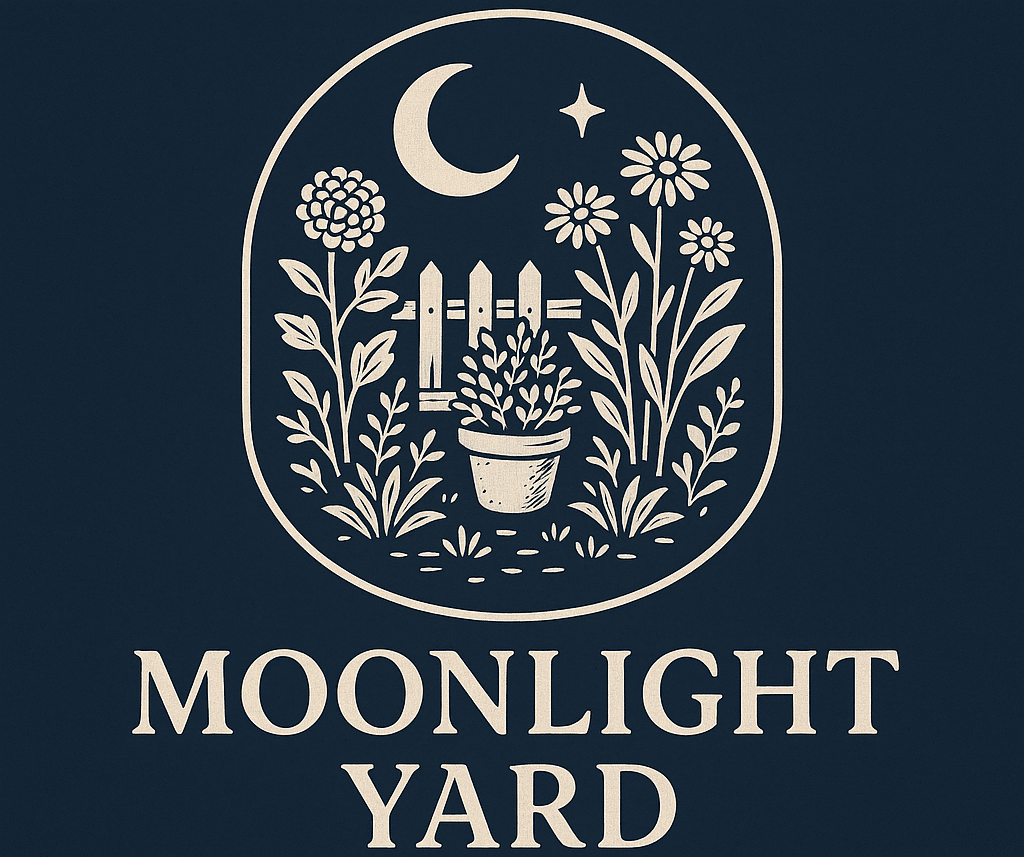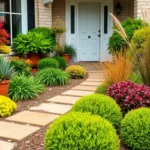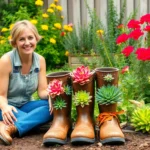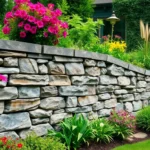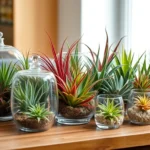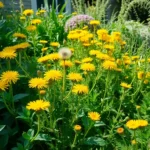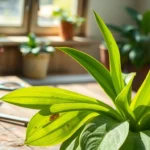Small front gardens pack incredible potential into compact spaces. We’ve discovered that even the tiniest front yard can become a stunning focal point that dramatically boosts your home’s curb appeal and property value. With the right design strategies you’ll transform your modest outdoor space into something truly spectacular.
We understand the unique challenges small front gardens present – from limited square footage to awkward layouts that seem impossible to work with. That’s exactly why we’ve compiled proven techniques that maximize every inch while creating visual impact that rivals much larger landscapes.
Whether you’re dealing with narrow strips of soil alongside your walkway or a petite patch in front of your townhouse we’ll show you how to make smart plant choices create depth through layering and use clever design tricks that make your space feel surprisingly spacious. Your small front garden is about to become your home’s greatest asset.
Create a Welcoming Entrance With Colorful Container Gardens
Container gardens offer the perfect solution for transforming small front gardens into vibrant, welcoming spaces. They provide flexibility and instant impact while allowing us to work within the constraints of limited space.
Choose Weather-Resistant Planters for Year-Round Appeal
Selecting durable containers ensures our front garden displays maintain their beauty through every season. Fiberglass planters resist cracking in freeze-thaw cycles and come in styles that mimic stone, wood, or ceramic at a fraction of the weight. Powder-coated metal containers like galvanized steel or aluminum provide modern appeal while withstanding harsh weather conditions for decades.
Ceramic and glazed pottery work well in moderate climates but require protection from extreme temperature fluctuations. We recommend choosing containers at least 12-16 inches in diameter to provide adequate root space and prevent rapid moisture loss. Drainage holes remain essential for plant health, so we drill additional holes if needed or add a layer of gravel at the bottom.
Resin composite planters offer another excellent option, combining the appearance of natural materials with superior weather resistance. These lightweight containers won’t fade, crack, or become brittle over time, making them ideal for areas with intense sun exposure or frequent temperature changes.
Select Low-Maintenance Plants That Thrive in Small Spaces
Choosing the right plants makes container gardening success achievable even for busy homeowners. Evergreen shrubs like boxwood, dwarf conifers, and compact holly varieties provide year-round structure with minimal care requirements. These plants tolerate container life well and maintain their shape with occasional pruning.
Ornamental grasses such as fountain grass, blue fescue, and Japanese forest grass add movement and texture while requiring little water once established. Succulents including hens and chicks, sedum varieties, and small agave species create striking displays in shallow containers and thrive on neglect.
Perennial flowers like lavender, coneflowers, and ornamental sage return each year with increasing beauty. We pair these with seasonal annuals such as petunias, marigolds, or pansies for continuous color throughout the growing season. Native plants adapted to our local climate typically require less water and maintenance while supporting local wildlife.
Hardy herbs including rosemary, thyme, and oregano serve double duty as aromatic foliage plants and culinary ingredients. These Mediterranean plants prefer well-draining soil and tolerate dry conditions, making them perfect for container culture.
Layer Heights With Cascading and Upright Plants
Creating visual depth transforms flat container displays into ever-changing focal points for our small front gardens. We position tall, upright plants like dwarf trees, columnar evergreens, or architectural grasses at the back or center of arrangements to establish vertical structure.
Mid-height plants such as compact shrubs, bushy perennials, or rounded ornamental grasses fill the middle layer and provide transition between heights. Mounding plants like coral bells, small hostas, or compact flowering shrubs create fullness without overwhelming the container.
Trailing plants including ivy, trailing petunias, sweet potato vine, or cascading succulents soften container edges and add graceful movement. We plant these spillers around the rim where they can flow naturally downward, creating the illusion of abundance even in small containers.
Grouping containers of varying heights amplifies this layering effect across our entire front garden space. We arrange tall containers behind shorter ones and use plant stands or inverted pots to create additional elevation changes that draw the eye upward and make our small space feel larger.
Design Vertical Gardens to Maximize Limited Space
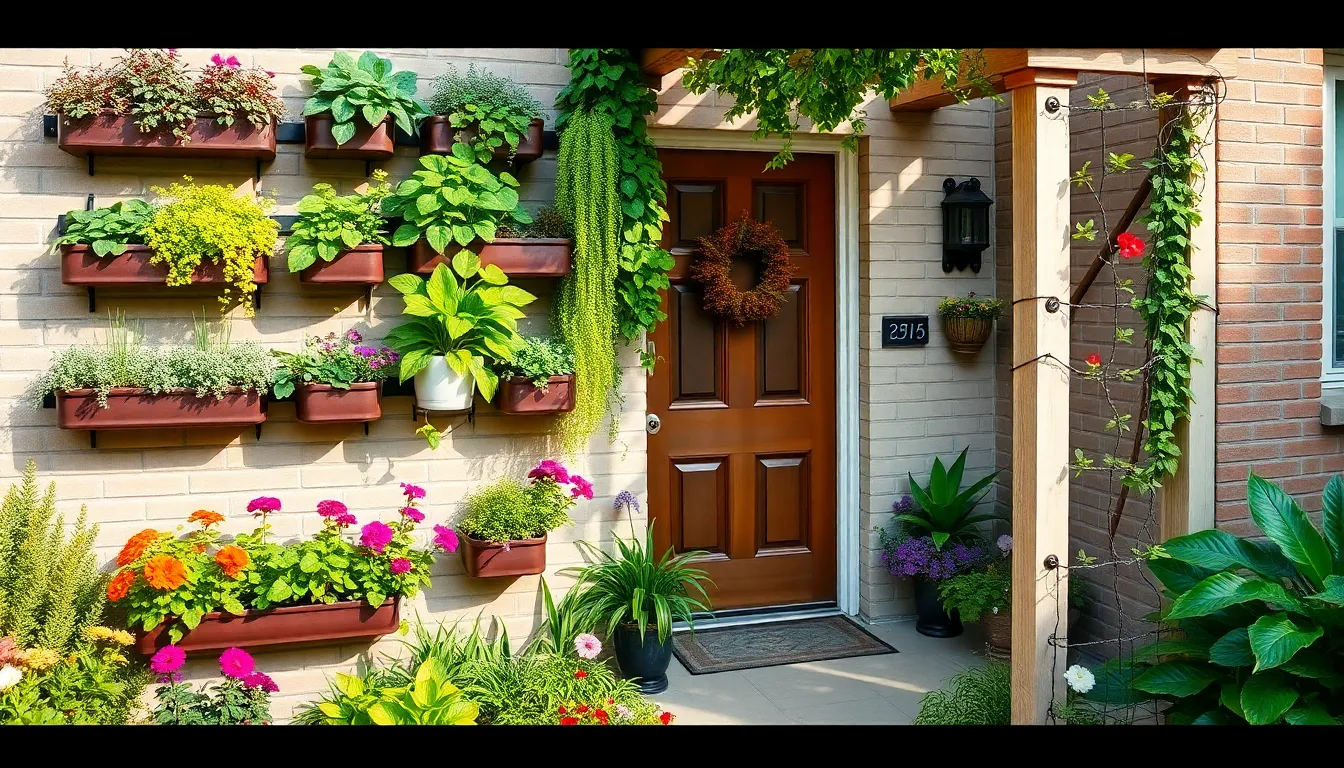
Moving up instead of out becomes essential when working with compact front yard areas. Vertical gardening transforms bare walls and fences into thriving green spaces that deliver maximum impact without consuming precious ground area.
Install Wall-Mounted Planters for Herbs and Flowers
Wall-mounted planters offer an efficient solution for growing both culinary herbs and colorful flowers in tight spaces. We recommend selecting sturdy planters that can support the weight of soil and plants while providing adequate drainage to prevent water damage to walls.
Herbs like basil and rosemary thrive in wall-mounted containers and provide fresh ingredients for cooking while adding pleasant fragrances to your entrance. These aromatic plants also require minimal maintenance and can withstand various weather conditions throughout the growing season.
Flowering options such as petunias and geraniums bring vibrant colors to vertical displays while requiring relatively simple care routines. These blooms create eye-catching focal points that draw attention upward and make small front gardens appear larger than their actual footprint.
Position wall-mounted planters at varying heights to create visual interest and ensure adequate sunlight reaches each container. This staggered arrangement prevents plants from shading each other while maximizing the available growing space on vertical surfaces.
Use Trellises for Climbing Vines and Vegetables
Trellises provide essential support structures for climbing plants while adding architectural interest to small front gardens. We’ve found that installing these vertical supports allows homeowners to grow upward rather than outward, preserving valuable ground space for other design elements.
Climbing vines such as ivy and clematis transform plain fences and walls into living backdrops that provide year-round greenery and seasonal blooms. These plants naturally spread across trellis surfaces, creating dense coverage that enhances privacy and reduces noise pollution from nearby streets.
Vegetable options like cucumbers and tomatoes can also use trellis systems effectively, allowing small front gardens to serve both decorative and functional purposes. This dual-purpose approach maximizes the utility of limited space while maintaining an attractive streetside appearance.
Choose trellis materials that complement your home’s exterior design while providing adequate strength for mature plant growth. Metal and wooden options both offer durability, though each requires different maintenance approaches to ensure long-term performance.
Create Living Walls With Pocket Planters
Living walls using pocket planters represent the ultimate space-saving solution for extremely compact front gardens. We attach these specialized planting systems directly to existing fences or exterior walls, creating dramatic vertical displays that require minimal ground clearance.
Pocket planters accommodate multiple plant varieties within a single vertical structure, allowing for diverse plantings that include flowers, herbs, and small foliage plants. This variety creates visual complexity and seasonal interest while maintaining the compact footprint essential for small front garden success.
Installation involves securing pocket planter systems to sturdy wall surfaces using appropriate mounting hardware that can support the combined weight of soil, plants, and water. Proper drainage systems prevent water damage to underlying structures while ensuring plant health throughout different weather conditions.
Living walls provide additional benefits beyond space efficiency, including improved air quality around your home’s entrance and enhanced insulation properties for exterior walls. These environmental advantages make pocket planter systems particularly valuable investments for urban and suburban properties with limited outdoor space.
Transform Your Pathway With Strategic Plant Placement
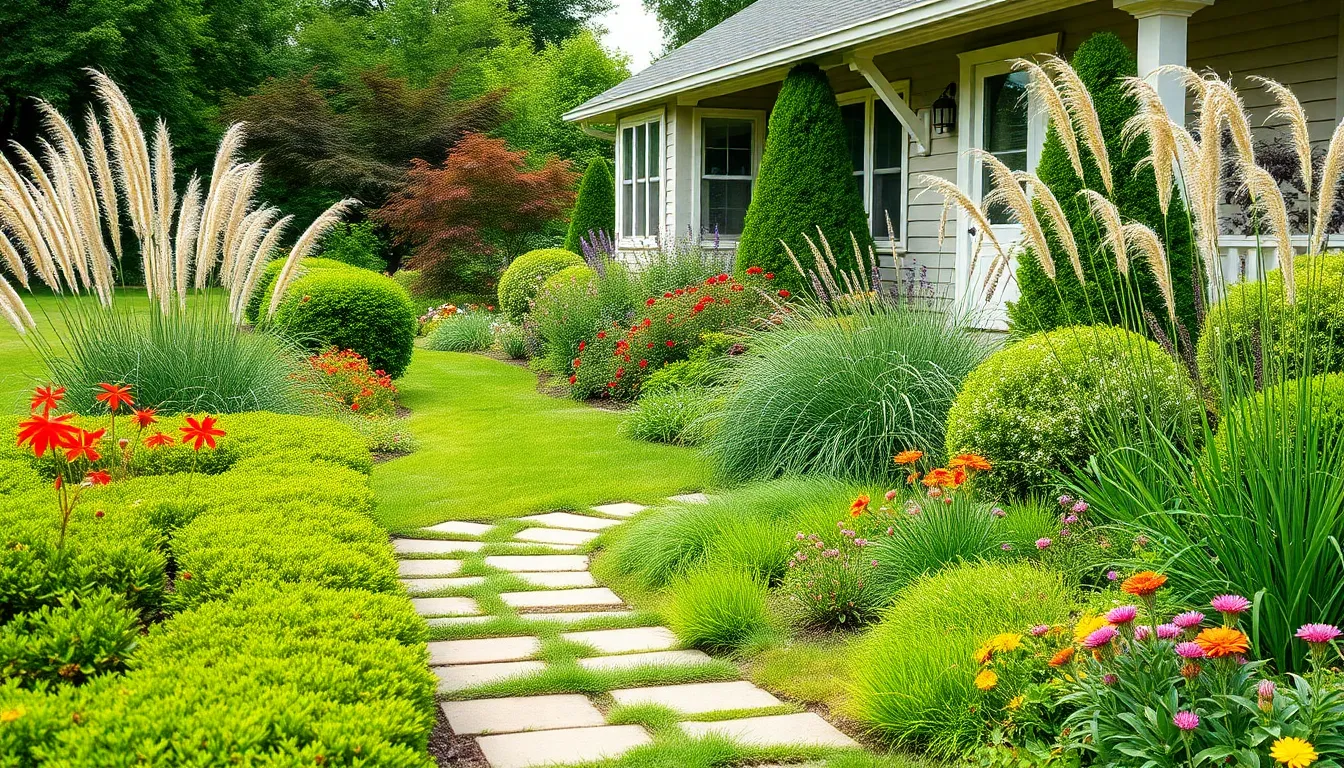
Creating a welcoming entrance transforms your small front garden by using plants to guide movement and enhance visual appeal. Positioning low-growing, compact plants along walkway edges defines the space while making your garden appear larger by drawing the eye forward.
Line Walkways With Compact Shrubs and Perennials
Compact shrubs create structure and year-round interest when placed along walkway borders. Small boxwoods, lavender, and dwarf ornamental grasses work perfectly for narrow borders while requiring minimal maintenance. These plantings prevent overcrowding and maintain clear sightlines throughout your pathway.
Perennial plants offer lasting value by returning each season with reliable growth patterns. Hardy varieties establish strong root systems that tolerate foot traffic and weather changes better than annuals. Selecting low-maintenance perennials reduces your gardening workload while providing consistent visual appeal.
Strategic placement along walkway edges ensures plants don’t interfere with foot traffic while maximizing their visual impact. Position shorter varieties closest to the path and gradually increase heights as you move away from walking areas. This creates a sense of order and continuity that makes small spaces feel more organized.
Add Seasonal Color With Border Plantings
Long-flowering perennials provide continuous blooms throughout much of the year with varieties like hardy geraniums, erigeron, and repeat-flowering roses. These plants offer exceptional value by producing multiple bloom cycles during growing seasons. Their extended flowering periods reduce the need for frequent replanting.
Annual flowers allow easy updates to your color schemes each season with options like petunias and marigolds. Mixing annuals with perennials creates opportunities to experiment with different color combinations. Seasonal plantings let you refresh your garden’s appearance without major redesign efforts.
Border positioning maximizes color impact by concentrating flowering plants where they’re most visible from pathways and entrances. Grouping similar colors creates bold statements while mixing complementary shades adds visual interest. Strategic color placement draws attention to your pathway and creates natural focal points.
Use Ornamental Grasses for Texture and Movement
Ornamental grasses add ever-changing interest to small front gardens through varieties like blue fescue and fountain grass. These plants require minimal maintenance while providing visual contrast with other plantings. Their graceful swaying with breezes creates movement that brings life to static garden spaces.
Textural variety enhances garden design by incorporating different leaf shapes, sizes, and growth patterns. Grasses offer fine, linear textures that contrast beautifully with broad-leafed plants and flowering varieties. This diversity prevents monotonous plantings while maintaining cohesive design themes.
Low-maintenance benefits make ornamental grasses ideal for busy homeowners who want attractive gardens without extensive upkeep. Most varieties tolerate drought conditions once established and require only annual cutting. Their resilience ensures consistent appearance throughout growing seasons with minimal intervention.
Incorporate Multi-Functional Garden Elements
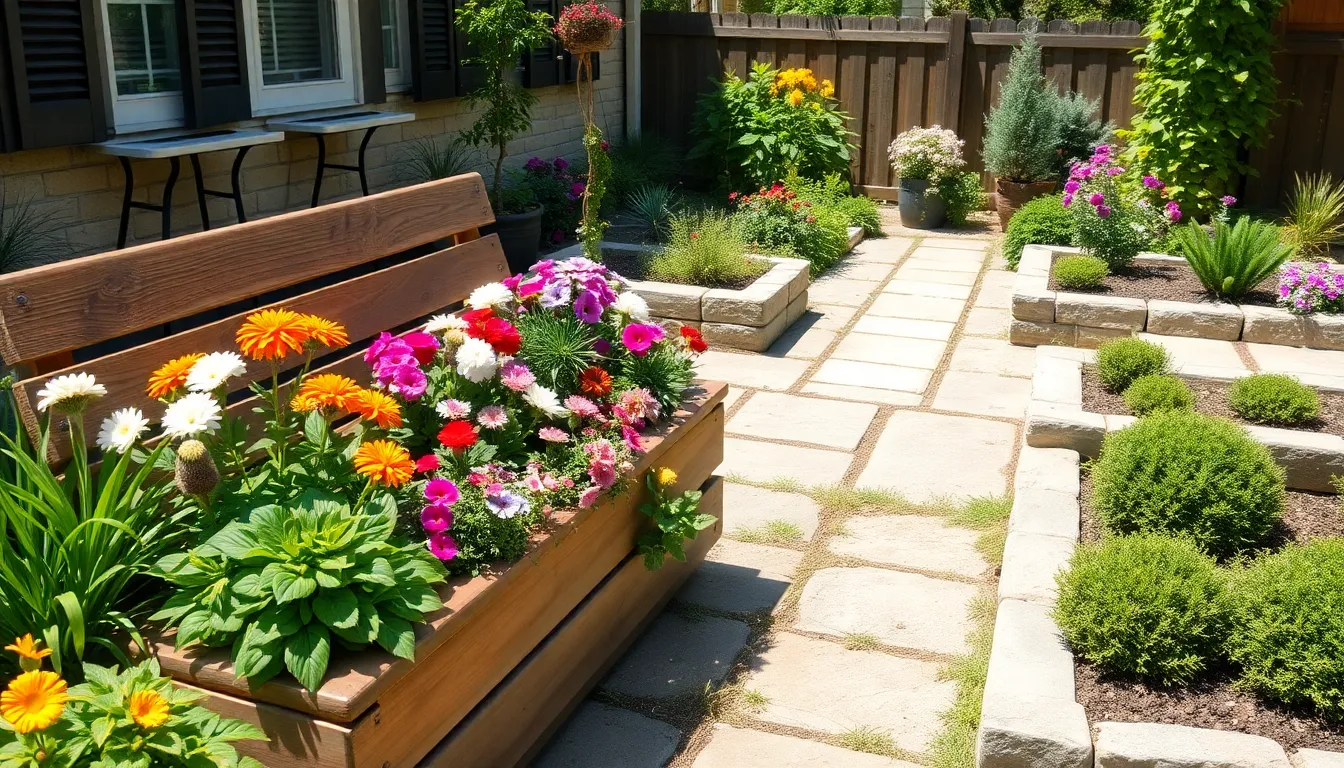
Smart multi-functional elements help us maximize every square foot of our small front gardens while creating practical answers for storage, seating, and growing space.
Choose Furniture That Doubles as Planters
Benches with built-in planters transform ordinary seating into functional garden features that serve multiple purposes. We recommend selecting pieces that combine sturdy construction with adequate drainage systems to protect both the furniture and plants. Tables featuring integrated planting compartments create unique focal points while providing surfaces for outdoor activities or displaying decorative items.
Wooden bench planters work exceptionally well along front walkways, offering guests a place to rest while showcasing seasonal flowers or herbs. Metal options with powder-coated finishes resist weather damage and complement modern home exteriors. Resin composite furniture planters require minimal maintenance while providing the appearance of natural materials.
Position these dual-purpose pieces strategically near entryways to create welcoming gathering spots that enhance both functionality and aesthetic appeal. Fill the planting sections with low-maintenance options like succulents, ornamental grasses, or compact evergreen shrubs that won’t overwhelm the furniture’s proportions.
Install Raised Beds With Built-In Seating
Raised planting beds with integrated seating areas maximize growing space while providing comfortable spots to enjoy our gardens. We can construct these features using materials like cedar, composite lumber, or stone to match our home’s architectural style. Design the seating height between 16-18 inches to ensure comfortable use for most adults.
Corner installations work particularly well in small front yards, creating natural gathering spaces that don’t interfere with foot traffic patterns. L-shaped configurations fit perfectly into awkward corners while providing ample planting area for flowers, herbs, or small vegetables. Built-in seating eliminates the need for separate outdoor furniture, freeing up valuable ground space for other design elements.
Consider adding cushions or weather-resistant pillows to enhance comfort during longer gardening sessions or relaxation periods. Install proper drainage in the planting areas to prevent water damage to the seating components and ensure healthy plant growth throughout the seasons.
Add Storage Answers That Blend With Your Design
Hidden storage compartments within garden benches keep tools, cushions, and seasonal decorations organized without cluttering our small spaces. We can select benches with lift-up seats that reveal waterproof storage areas perfect for gardening supplies or outdoor accessories. Wooden options with hinged tops complement traditional home styles while providing practical functionality.
Planters with built-in storage compartments serve dual purposes by housing both plants and garden essentials. These innovative designs feature hidden sections beneath the planting area for storing small tools, fertilizers, or watering accessories. Choose materials that resist moisture damage to protect stored items from weather exposure.
Storage ottomans designed for outdoor use create additional seating while concealing items we need regularly but don’t want visible. Position these pieces near seating areas or along pathways where they’ll provide both convenience and functionality. Select weather-resistant fabrics and frames that complement our existing garden color scheme and design aesthetic.
Establish Focal Points With Eye-Catching Features
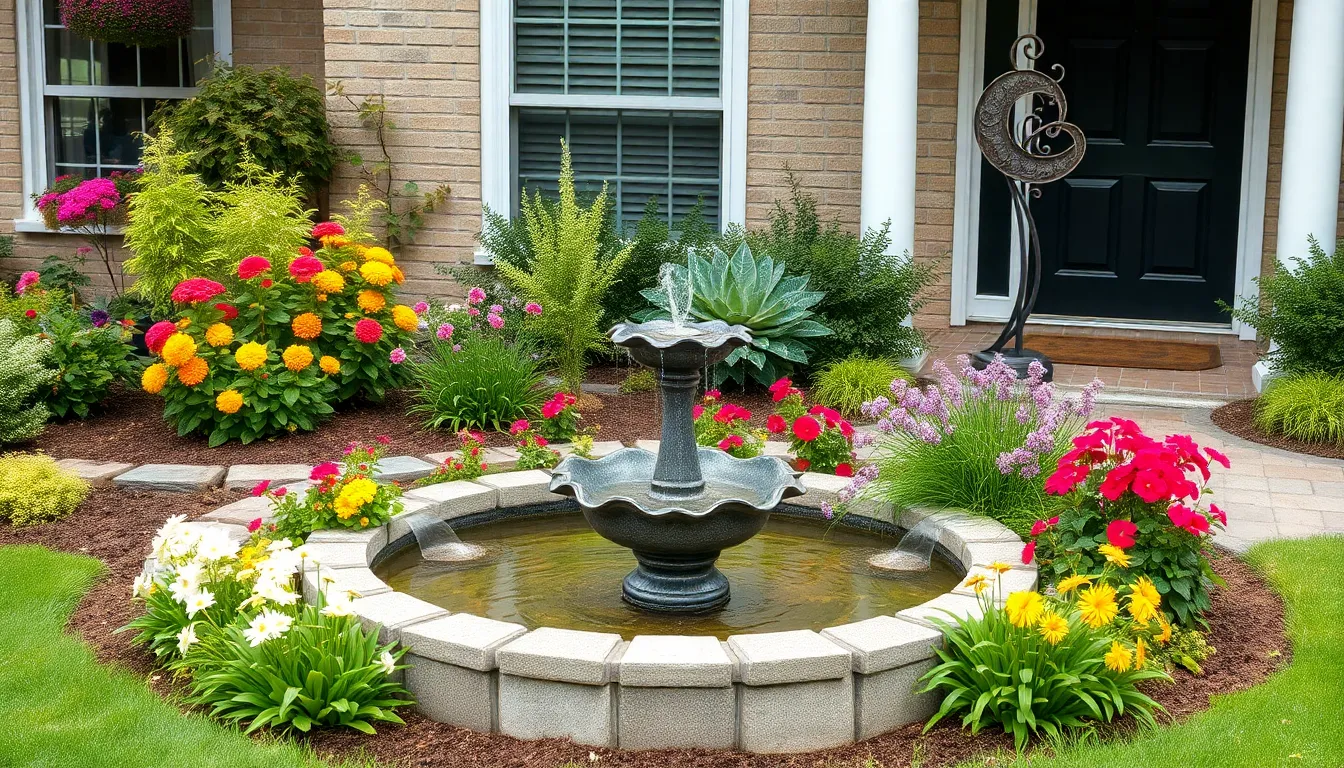
Strategic focal points transform small front gardens from ordinary spaces into captivating displays. These carefully chosen elements draw attention and create visual depth that makes limited areas feel more expansive and thoughtfully designed.
Create Drama With a Small Water Feature
Water features bring instant tranquility and sophistication to compact front gardens. A birdbath positioned near the entrance creates a welcoming atmosphere while attracting beneficial wildlife like birds and butterflies to your space.
Small fountains work exceptionally well in tight areas, producing soothing sounds that mask street noise and create a peaceful environment. The gentle bubbling draws the eye upward and makes your garden feel larger than its actual footprint.
Position your water feature where it’s visible from both the street and your front door to maximize its impact. We recommend choosing self-contained options that don’t require complex plumbing installations, making them perfect for renters or budget-conscious homeowners.
Use Decorative Sculptures or Garden Art
Garden sculptures add personality and visual interest without requiring growing space or maintenance. Strategically placed art pieces guide visitors’ eyes through your garden, creating a sense of journey even in the smallest areas.
Metal sculptures reflect light and add contemporary flair to modern front gardens. Choose weather-resistant materials like powder-coated steel or aluminum that maintain their appearance through seasonal changes.
Stone or ceramic pieces blend naturally with planted areas and provide year-round structure. Position these elements at different heights to create layers and prevent your garden from appearing flat or one-dimensional.
Consider the scale carefully when selecting garden art for small spaces. Oversized pieces can overwhelm compact areas, while multiple smaller sculptures create visual clutter that detracts from your garden’s overall impact.
Plant a Specimen Tree as a Central Anchor
Specimen trees serve as living focal points that provide structure and seasonal interest throughout the year. Dwarf or compact varieties offer the benefits of larger trees without overwhelming small front gardens.
Choose trees with multiple seasons of appeal, such as flowering cherries that bloom in spring and display colorful fall foliage. These multi-interest specimens maximize your investment in limited space.
Position your specimen tree slightly off-center rather than directly in the middle to create more ever-changing visual composition. This asymmetrical placement feels more natural and allows space for complementary plantings around the base.
Consider the mature size when selecting your tree to prevent future overcrowding issues. Dwarf varieties of popular species like Japanese maples, ornamental pears, or flowering dogwoods provide full-sized impact in appropriately scaled packages.
Maximize Curb Appeal With Low-Maintenance Landscaping
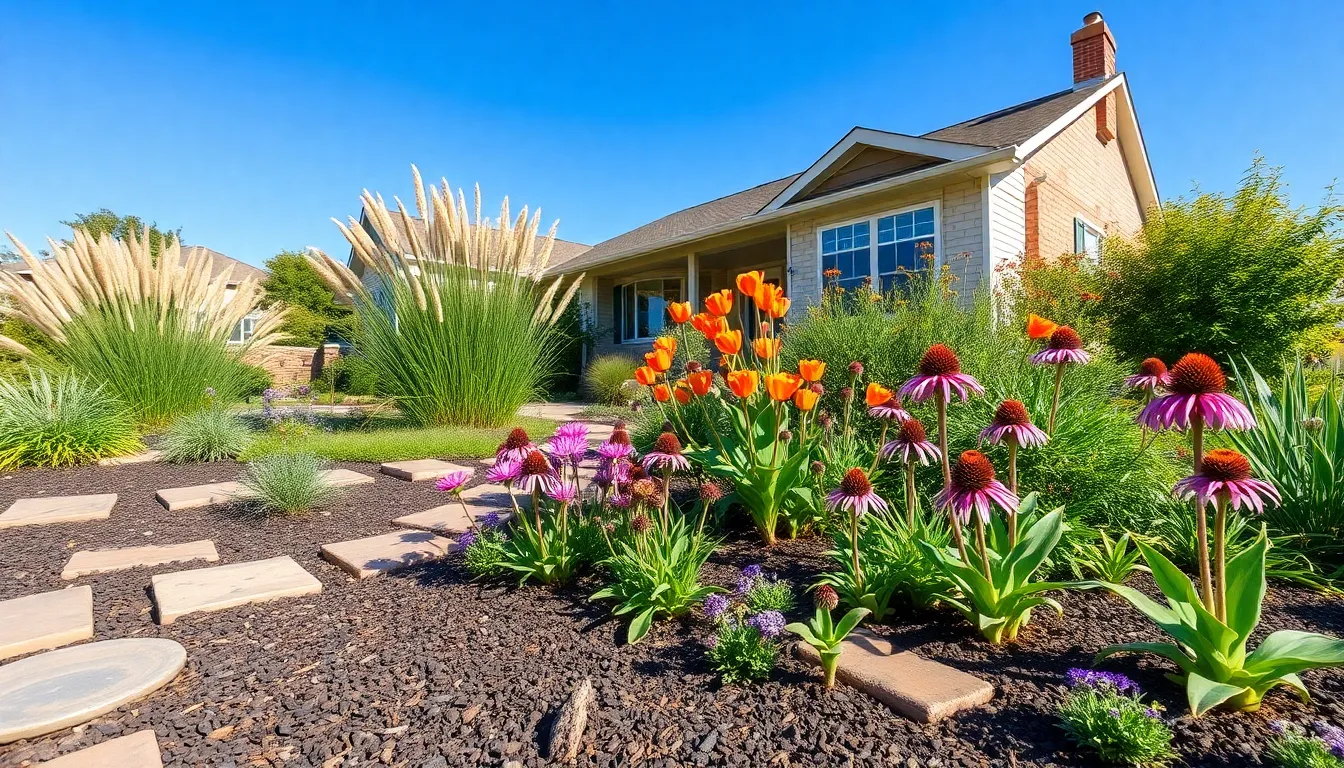
Low maintenance landscaping transforms small front gardens into stunning focal points without demanding endless hours of upkeep. Smart plant selections and strategic design choices create beautiful spaces that practically care for themselves.
Choose Native Plants for Easy Care
Native plants thrive naturally in local conditions, requiring minimal water and maintenance once established. We recommend selecting native grasses like buffalo grass or blue grama that adapt perfectly to regional weather patterns and soil types. These hardy varieties resist pests and diseases better than exotic alternatives, reducing the need for chemical treatments or frequent replacements.
Perennial bulbs offer year-round interest with virtually no maintenance requirements. Spring bulbs like native crocuses and wild tulips emerge automatically each season, while fall-blooming varieties extend color well into cooler months. Plant these bulbs once and enjoy decades of reliable blooms without replanting or special care.
Drought tolerant plants significantly reduce water consumption while maintaining visual appeal throughout dry spells. Native sedums, yuccas, and regional wildflowers flourish with natural rainfall alone. These resilient plants develop deep root systems that access groundwater, making them perfect for busy homeowners who travel frequently or prefer minimal garden maintenance.
Use Mulch and Stones for Clean, Finished Looks
Mulch creates professional looking borders while serving practical functions that save time and effort. Organic mulch like shredded bark or leaf mold prevents weed growth by blocking sunlight from reaching unwanted seeds. This natural barrier reduces weeding time by up to 80% compared to bare soil areas.
Stone pathways and borders add sophisticated structure that requires zero ongoing maintenance. River rocks, decomposed granite, or native stone create permanent features that define garden spaces without seasonal upkeep. These materials also improve drainage around plant roots, preventing moisture related problems that damage delicate specimens.
Combining mulch and stone elements creates layered textures that add visual depth to compact spaces. Place larger stones as accent pieces among mulched planting areas to establish focal points that draw the eye through your garden design.
Plan for Three-Season Interest With Varied Textures
Varied textures create ever-changing visual appeal that changes throughout growing seasons. Mix smooth river stones with rough bark mulch and soft ornamental grasses to establish contrast that remains interesting year-round. These textural combinations prevent monotony while requiring minimal seasonal adjustments.
Seasonal interest planning ensures your garden looks intentional during spring, summer, and fall months. Plant early blooming natives like wild lupine for spring color, summer flowering black-eyed Susan for mid-season impact, and fall blooming asters for extended seasonal appeal. This strategic timing creates continuous color waves without overlapping maintenance periods.
Flower gardens featuring mixed annuals and perennials provide ongoing blooms throughout active growing seasons. Combine low maintenance perennials like purple coneflowers with easy care annuals such as zinnias or marigolds. This approach delivers maximum visual impact while concentrating care efforts during exact planting windows rather than constant daily maintenance.
Design Themed Gardens for Cohesive Style

Creating a cohesive design theme transforms small front gardens into polished spaces that feel intentional and well-planned. We can achieve stunning results by selecting complementary elements that work together harmoniously.
Create a Modern Minimalist Look With Geometric Shapes
Geometric planters instantly create a modern aesthetic that maximizes visual impact in small spaces. We recommend choosing square, rectangular, or cylindrical containers in materials like concrete, fiberglass, or powder-coated metal for clean lines that define the minimalist approach.
Simple color schemes work best for maintaining this sophisticated look. Stick to monochromatic palettes using white, gray, or black planters filled with green foliage plants like boxwood, ornamental grasses, or architectural succulents such as agave or yucca.
Sculptural elements add artistic flair without overwhelming compact areas. Consider incorporating geometric garden sculptures, modern birdbaths, or contemporary water features that complement your planter shapes while serving as focal points.
Symmetrical arrangements enhance the minimalist aesthetic by creating balance and order. Place matching planters on either side of entrances or arrange geometric containers in linear patterns along pathways to establish visual rhythm throughout your front garden design.
Develop a Cottage Garden Feel With Mixed Plantings
Mixed plantings create the lush, abundant look characteristic of cottage gardens even in limited spaces. Combine various flowers and plants to achieve a naturally informal appearance that feels welcoming and established.
Perennials like hardy geraniums and shrub roses provide long-lasting blooms throughout multiple seasons. These reliable performers require minimal maintenance while delivering continuous color and fragrance that defines the cottage garden charm.
Arched trellises covered in climbing vines serve as perfect focal points for small cottage-style gardens. Install these structures to support clematis, climbing roses, or sweet peas that add vertical interest while maximizing growing space efficiently.
Layered heights create depth and visual interest in cottage plantings. Position taller plants like delphiniums or hollyhocks toward the back, medium-height perennials in the center, and low-growing annuals like alyssum or lobelia along borders to achieve the characteristic cottage garden abundance.
Establish a Mediterranean Vibe With Drought-Tolerant Plants
Drought-tolerant plants form the foundation of Mediterranean-style gardens that thrive with minimal water requirements. Incorporate succulents, lavenders, and rosemary to create aromatic, textured landscapes that flourish in sunny conditions while reducing maintenance demands.
Earthy tones enhance the Mediterranean atmosphere through thoughtful container and hardscape choices. Use terracotta pots, natural stone pavers, and warm-colored gravel to establish the sun-baked aesthetic characteristic of coastal Mediterranean regions.
Structural plants like olive trees, agave, or ornamental grass create dramatic focal points in small Mediterranean gardens. These architectural specimens provide year-round interest while requiring minimal care once established in appropriate growing conditions.
Gravel pathways and decorative stones complete the Mediterranean look while improving drainage around drought-tolerant plantings. Choose materials in warm tones like buff, tan, or terra cotta to complement your plant selections and create cohesive design flow throughout your compact front garden space.
Budget-Friendly Solutions for Small Front Garden Makeovers
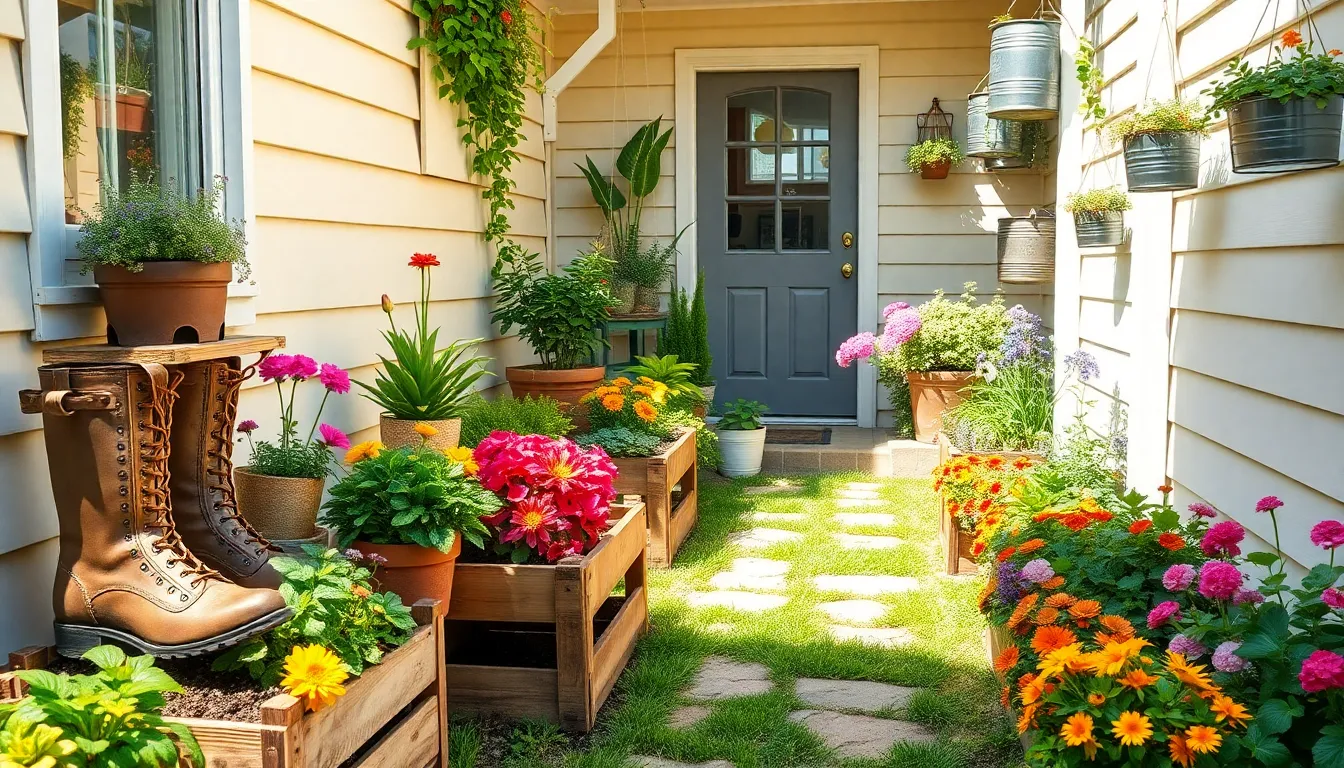
Transforming your small front garden doesn’t require a massive investment when you carry out smart cost-saving strategies. We’ll show you proven methods that maximize visual impact while minimizing expenses.
Repurpose Household Items as Unique Planters
Repurposing household items creates distinctive planters while reducing waste and saving money. Old boots make charming containers for small flowering plants and add whimsical character to your entrance. Wooden crates work perfectly for herb gardens and can be stacked to create vertical growing displays.
Plastic containers from your kitchen transform into functional planters with proper drainage holes added. Rain boots that are no longer wearable become conversation-starting planters for succulents or small shrubs. Large tin cans painted in coordinating colors create cohesive planter groupings along walkways.
Storage baskets lined with plastic provide excellent drainage for larger plants like ornamental grasses. Colanders make ideal hanging planters since they already have built-in drainage holes. Old wooden drawers can house multiple small plants while adding vintage charm to your garden design.
Start Plants From Seeds for Maximum Savings
Starting plants from seeds delivers important cost savings compared to purchasing mature seedlings. Buying seeds in bulk reduces per-plant costs dramatically while allowing you to grow exactly the varieties you want. Seeds for popular front garden plants like marigolds and zinnias cost pennies compared to buying established plants.
Annual flowers grown from seed provide maximum color impact at minimal expense. Sunflowers started indoors can create stunning focal points for less than a dollar per plant. Herb seeds like basil and parsley germinate quickly and provide both visual appeal and culinary benefits.
Perennial seeds require patience but offer exceptional long-term value once established. Native wildflower seed mixes cost significantly less than individual plants while creating natural-looking displays. Starting seeds indoors extends your growing season and increases success rates in small spaces.
Use Perennials for Long-Term Value
Perennials provide exceptional return on investment since they return year after year without replanting. These plants establish strong root systems that become more robust each season while requiring minimal ongoing maintenance. Daylilies offer continuous blooms throughout summer and multiply naturally to fill larger areas over time.
Hostas thrive in shaded front garden areas and expand their coverage annually without additional purchases. Ornamental grasses like fountain grass provide four-season interest while requiring virtually no care once established. Sedum varieties create colorful ground cover that spreads naturally while tolerating drought conditions.
Coneflowers attract beneficial pollinators and self-seed to create new plants in subsequent years. Black-eyed Susans provide bright yellow blooms from summer through fall and naturalize easily in small spaces. Astilbe offers elegant plumes in shaded areas and multiplies through division for future plantings.
Conclusion
We’ve explored countless ways to transform your small front garden into a captivating entrance that boosts your home’s curb appeal. From vertical gardening answers to budget-friendly DIY approaches every strategy we’ve shared focuses on maximizing impact while minimizing maintenance.
Your compact outdoor space holds incredible potential regardless of its size or current condition. Whether you choose container gardening for flexibility low-maintenance native plants for sustainability or themed designs for personality the key lies in thoughtful planning and creative implementation.
Remember that great front gardens aren’t defined by square footage but by smart design choices. With these proven techniques you’re ready to create an inviting entrance that welcomes guests enhances your property value and brings you joy every time you come home.
Frequently Asked Questions
What are the benefits of improving a small front garden?
Small front gardens can significantly enhance your home’s curb appeal and increase property value. Even the tiniest spaces can create a welcoming entrance and positive first impression. With the right design strategies, these compact areas become valuable assets that require minimal maintenance while maximizing visual impact.
What are the best container options for small front gardens?
Weather-resistant planters are essential for year-round appeal. Fiberglass, powder-coated metal, and resin composite containers offer durability and style. These materials withstand various weather conditions while providing excellent drainage. Choose containers in varying heights to create visual depth and interest in your compact space.
Which plants work best in small front garden spaces?
Low-maintenance plants that thrive in compact areas include evergreen shrubs, ornamental grasses, succulents, perennial flowers, and hardy herbs. These varieties require minimal care while providing year-round structure and seasonal interest. Native plants are particularly beneficial as they’re adapted to local conditions and need less water and maintenance.
How can I make my small front garden look bigger?
Create visual depth by layering plants with tall varieties at the back, mid-height plants in the middle, and trailing plants at the edges. Use vertical gardening techniques like wall-mounted planters and trellises. Group containers of varying heights and incorporate ornamental grasses to add movement and texture that draws the eye throughout the space.
What are some budget-friendly ideas for small front garden makeovers?
Repurpose household items like old boots, wooden crates, and containers as unique planters. Start plants from seeds instead of buying mature plants for significant savings. Focus on perennials that return year after year, providing long-term value. Use mulch and stones for clean, finished looks while reducing maintenance costs.
How do I create a cohesive design theme in my small front garden?
Choose a specific style and stick to it. For modern minimalist looks, use geometric shapes and monochromatic color schemes. Cottage garden aesthetics work well with mixed plantings for a lush feel. Mediterranean themes incorporate drought-tolerant plants with earthy tones and decorative stones for structural interest.
What vertical gardening options work for small spaces?
Install wall-mounted planters for herbs and flowers, ensuring they have proper drainage. Use trellises to support climbing vines and vegetables like cucumbers and tomatoes. Living walls with pocket planters maximize space while improving air quality. These solutions preserve ground space while adding greenery and visual interest.
How can I reduce maintenance in my small front garden?
Choose native plants adapted to your local climate, as they require less water and care. Use drought-tolerant varieties to minimize watering needs. Apply mulch to suppress weeds and retain moisture. Plan for three-season appeal with strategic plant placement, and select perennials over annuals for long-term, low-maintenance beauty.
